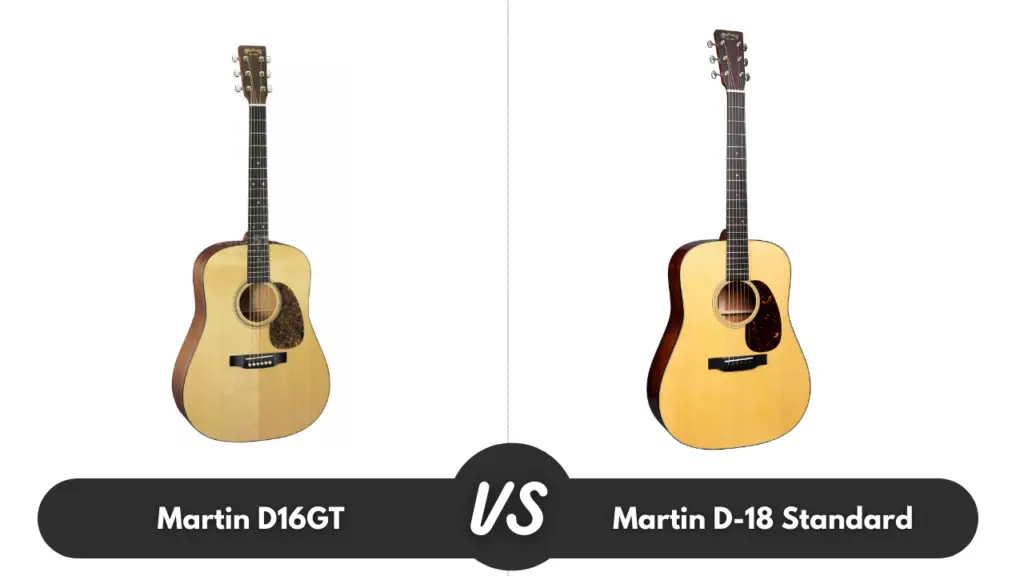Martin guitars have been making popular, top-notch performance and long-life build guitars for many years. With the brand being around for 180 years they have designed an array of acoustic guitars for guitarists with different playing styles.
One of the benefits of getting a Martin guitar is due to the high-quality wood and advanced electronics. Two popular Martin models that we’ll be looking at are the D16GT and the D-18 Standard Series.
| Features: | Martin D16GT | Martin D-18 Standard Series |
|---|---|---|
| Bracing: | Scalloped | Forward-Shifted X-Brace |
| Top: | Solid Sitka Spruce | Sitka Spruce |
| Neck: | Select Hardwood | Select Hardwood |
| Frets: | 20 | 20 |
Martin D16GT
Martin has been making some genuinely fantastic guitars and the D16GT is among the finest examples of their craftsmanship and skill. With its great tone, stunning finish, great construction and top-quality hardware the D16GT is a guitar that you need to try for yourself.
Design
Body & Neck
You don’t need to take more than a quick glance at the D16GT to recognize that it’s a Martin, with its classic dreadnought shape and an air of understated elegance. Diving deeper into the D16GT, you’ll find that the body is exceptionally crafted from solid Sitka spruce on the top, while the back and sides are made with solid mahogany.
Unlike some of Martins’s higher-end guitars, the D16GT features simple detailing, such as the polished gloss finish on the top, striped herringbone rosette, along with black Boltaron binding around the body.
The neck on this model is quite interesting. The neck features a ‘select hardwood’ build, which some say is mahogany, some Spanish cedar. It nevertheless has a lovely feel in the hands with a low oval profile and satin finish. Although, the main interest lies in the fretboard, which is made of Richlite, which is an FSC-Certified material made from compressed paper.
In today’s market, Martin is one of the most notable leaders when it comes to using environmentally-sustainable materials in their guitars and some of their higher-end models are no exception. While some more traditional players may scoff at the environmentally friendly material, the Richlite is an excellent material and is becoming the standard for Martin guitars. Its appearance features a dark ebony-like shade, it’s incredibly hard and durable, and very slick, making it an excellent choice.
Hardware
While the hardware of the D16GT won’t blow anybody away, it’s defiantly appropriate for the price range. As there’re no electronics to talk of, while look at things like the tuners and bridge. Martin-branded tuners are made of chrome and are closed-gear with a smooth, precise operation. The guitar’s bridge is also made from Richlite and features a compensated White Tusq saddle.
Sound
As for the sound, it’s really impressive! The first thing you notice once you’ve strummed the D16GT is the booming low-end it delivers. But, despite the D16GT giving such emphasized bass, it still remains warm and articulate throughout and doesn’t overpower the mids or trebles. This model features the bold projection you would expect from any other Martin dreadnought, so even when it’s unplugged it’s pretty loud. Overall, it’s acoustically versatile and feels as comfortable with blues fingerstyle as it does aggressive acoustic rock strumming.
Martin D-18
Martin’s D-18 is probably their most popular model and one of the best dreadnoughts out there. With a great-sounding combo of solid Sitka spruce top and mahogany sides and back, a smooth fingerboard and a bone nut and saddle for improved intonation, it’s not hard to contemplate that we’re talking about a high-end acoustic guitar that will not disappoint the user in any aspect.
Design
To begin with, Martin’s D-18 consists of a solid Sitka spruce soundboard with a fairly tight, straight grain.
Additionally, the back and sides are constructed from solid mahogany and the two-piece back is separated by a simple black Boltaron pinstripe. Both the front and back are joined with tortoiseshell effect binding, meeting the pickguard, and the soundboard binding is expanded with uncomplicated white and black tinted Boltaron coachlining.
Moving on to the neck which is mahogany with a satin finish, that’s suited to the body employing a dovetail joint and the fit and craftsmanship is first-rate. Each joint, line and fixing are finished perfectly, meaning that Martin’s expected high standards of presentation are reached, if not bettered here.
When it comes to the bridge, it’s made of solid black ebony, and it has the ’30s style belly with a drop-in saddle, while string spacing at the bridge is 2-3/16 in and the radius of the intonation-compensated bone saddle is 16 in.
The D-18’s tuning machines are nickel open-geared models with butterbean knobs, and the pickguard is a tortoise-colored Delmar, meaning the ≈ comes strung with Martin Studio Performance Lifespan Phosphor Bronze medium gauge strings.
Sound
Aesthetically, when you first pick up the guitar, there’s a sense of gravity, importance, and history. If you didn’t know, this guitar was there through the early days of country and western, right through to rock and roll and folk.
When it comes to its tonality, Martin’s Dreadnought is known for producing crisper and smoother, powerful yet controlled tonality than its predecessors, reacting almost instantly with precision and to the slightest change in dynamics.
If you play this guitar softly, the tone becomes reasonable and delicate, while if you pick it harder, the top starts to vibrate, so this tells how realistic this guitar can be.
Conclusion
To most experienced guitar players there can be a discernible difference between Martin’s various models. While the D16GT is a fine student-level model for an affordable price, the D-18 is considered to be a higher-level guitar.
In regards to the sound, it has more of everything that makes the D16GT good. The D-18 has more volume, a stronger fundamental tone, clearer ringing trebles, with balanced clear bass.
